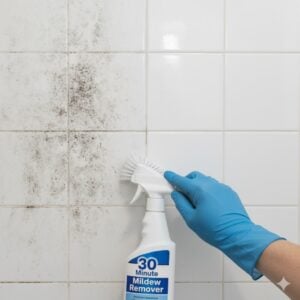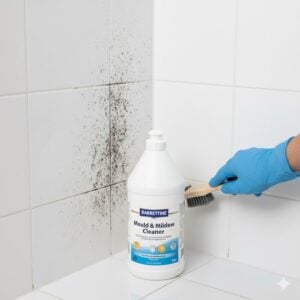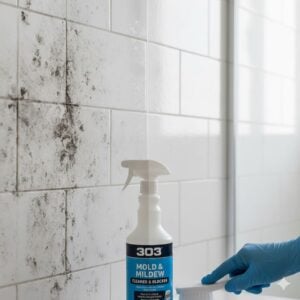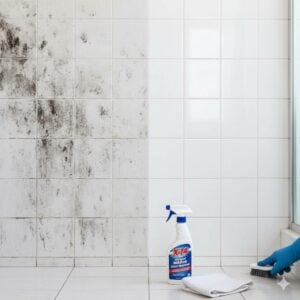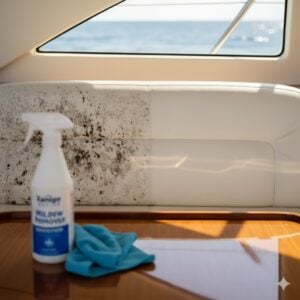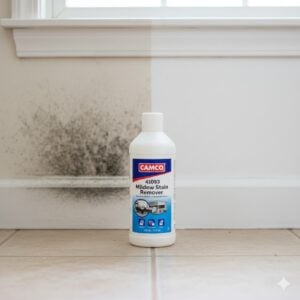Mildew often sneaks up quietly. You might not even notice it until a faint musty smell fills the air or you spot a strange patch on your bathroom ceiling. But what does mildew really look like? And how can you tell the difference between mildew and other household threats like mold or dirt?
In this guide, we dive into the colors of mildew, where it usually shows up in UAE homes, and what each shade could mean. With the heat and humidity across Dubai and the Emirates, recognizing mildew early can help you prevent larger problems before they start.
Table of Contents
Toggle1. What Color Is Mildew Usually?
Mildew typically appears in shades of gray, white, or light yellow. Unlike black mold, which is dark, raised, and more aggressive, mildew tends to look flat and powdery or fluffy—almost like dust settled on a surface.
Here’s how to identify mildew by color:
- White mildew: Often the earliest stage, seen on walls, windowsills, and fabric. It looks like a chalky residue.
- Gray mildew: Slightly older and more established. Appears on tiles, grout, or painted surfaces in moist areas like bathrooms.
- Yellowish mildew: Can occur on wallpaper, ceiling corners, or behind cabinets where airflow is poor.
The lighter tone of mildew often leads people to ignore it. But make no mistake—mildew is still a fungus, and it can damage surfaces and impact your health if left untreated.
2. Can Mildew Be Black, Green, or Other Colors?
Yes, but that’s where confusion with mold often begins. Mildew and mold are both fungi, but mold tends to be more dangerous and harder to remove. That said, advanced mildew can sometimes shift colors or mix with mold colonies.
Color indicators to keep in mind:
- Black: Usually a sign of mold, not mildew. Black growths—especially slimy or textured ones—should be handled professionally.
- Green: Could be either. If it’s flat and spreads in a dusty ring, it might be mildew. If it’s fuzzy or slimy, it’s likely mold.
- Pink or orange: Common in bathrooms. This isn’t mildew—it’s often a type of bacteria (like Serratia marcescens), but people often mislabel it.
If you’re unsure what you’re dealing with, don’t guess. A simple test or inspection can tell whether you’re dealing with a minor mildew problem or a deeper mold issue that needs remediation.
3. Where Do Mildew Colors Commonly Appear in UAE Homes?
In the UAE’s climate, mildew can develop faster than expected, especially in places with poor ventilation or excess moisture. While AC systems keep homes cool, they can also create humidity pockets, especially near vents, in closets, or behind furniture.
Typical places where you’ll spot mildew based on color:
| Area | Common Mildew Color |
|---|---|
| Bathroom ceilings and grout | Gray or yellowish mildew |
| Window tracks and corners | White or light gray mildew |
| Closets and behind furniture | Yellow or brownish patches (often mixed with dust) |
| Wallpaper or painted drywall | White or yellow mildew stains |
These colors might look harmless at first—but once mildew takes root, it feeds on organic matter like paper, fabric, or paint and can spread quickly.
4. Does Mildew Color Tell You If It’s Dangerous?
Mildew color alone doesn’t always indicate danger, but it can give you clues:
- White mildew is usually early-stage and easier to remove.
- Gray mildew may mean the colony has been active for some time.
- Yellow mildew often signals poor ventilation or ongoing humidity.
- Darker spots (black or dark green) could be signs of something more harmful—potentially mold or mixed colonies.
For people with allergies, asthma, or weakened immune systems, any form of mildew—even light-colored—can still trigger symptoms like sneezing, watery eyes, skin irritation, or coughing.
We always recommend tackling mildew early, before it becomes a health issue or damages your walls and air quality. If in doubt, get a quick inspection to rule out deeper fungal growth.
5. How to Deal with Mildew—No Matter the Color
No matter the color, mildew should be removed immediately—and the cause of moisture addressed to prevent recurrence. Here’s how you can approach it:
- Clean small patches with vinegar, hydrogen peroxide, or a diluted bleach solution (never mix cleaners!).
- Ensure airflow by using exhaust fans, dehumidifiers, or simply keeping doors open in closed spaces.
- Inspect for hidden leaks in AC systems, behind cabinets, or under flooring.
- Use mildew-resistant paint in bathrooms or damp areas.
- Call professionals like Bio-On if the area is large, recurring, or near air ducts or bedrooms.
Mildew doesn’t always look threatening—but that’s the problem. Its subtle colors allow it to spread under the radar. Stay alert and act early.
Conclusion
Mildew comes in many colors—white, gray, yellow—and each one can hint at its age, environment, and level of risk. In a humid country like the UAE, these small fungi can quickly become a nuisance if ignored.
We recommend regular inspections and proactive cleaning, especially in areas with poor air circulation. If you’re dealing with suspicious patches or uncertain whether it’s mildew or mold, just click the contact button on the right-middle of this post, and we’ll guide you through the best next steps.








